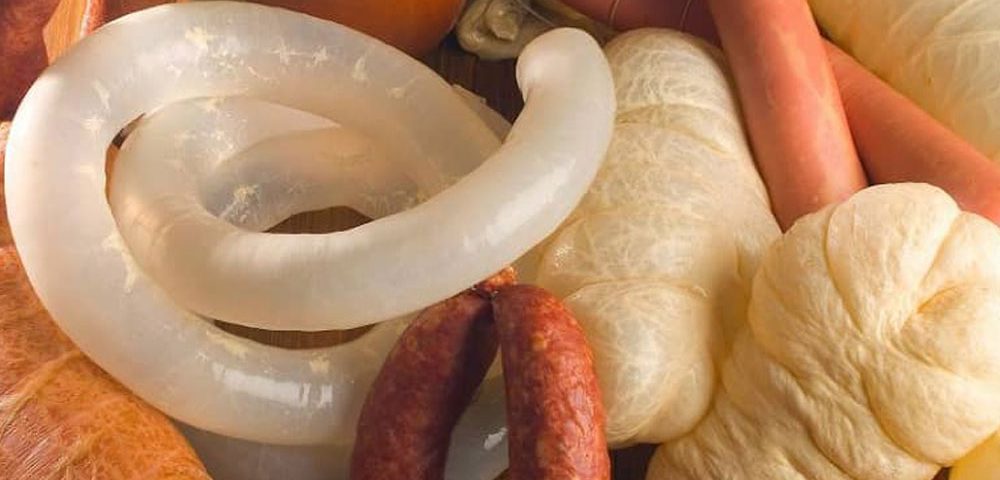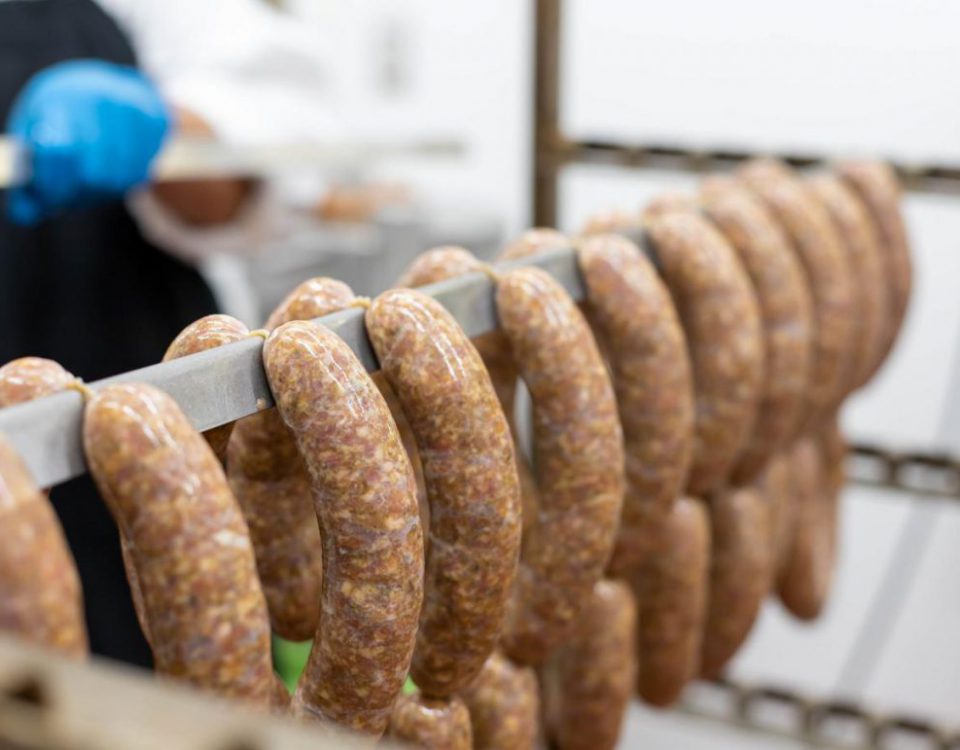فواید غذایی روده ی دام چیست ؟
July 6, 2021
استاندارد های پوشش روده ی طبیعی
July 9, 2021This post is also available in: Persian
General requirements
Edible natural casings shall:
a) be obtained from healthy animals slaughtered in licensed premises and subjected to ante-mortem and
post-mortem inspection according to the procedure prescribed in US CAC/RCP 58
b) be clean, safe and suitable for the intended purpose, prepared and handled in a sanitary manner and
where no contamination or exposure to infectious material during handling
c) be prepared under hygienic conditions and shall be wholesome not have been subjected to any
bacterial activation or fermentation
d) quality of water used for processing shall be of potable quality and in accordance with US EAS 12.
e) be strong enough to resist the pressure produced by filling them with sausage mix
f) be permeable to water vapor and gases, thus allowing fillings to dry
g) absorb smoke for additional flavor and preservation
h) expand or shrink firmly attached to the sausage mix
i) be closed at the ends by tying or clipping
j) free from foreign matter and odor
k) be free from any parasitic infestation and from scars of healed-up wounds
Types of edible natural casings
Edible natural casings shall be from;
a) Dried cattle casings known commercially as ‘Beef Casings’
b) Salted cattle casings known commercially as ‘Beef Casings’
c) Salted sheep or goat casings known commercially as ‘Sheep or goat Casings’
d) Salted pig casings known commercially as ‘pig Casing’.
Casing defects
Edible natural casings shall be free of the following defects;
a) Dull color: (grayish or greenish instead of white or milky) due to defective cleaning.
b) Nodules: due to oesophagostomum (a round worm) in the intestines of sheep, goat and pigs
c) Holes and lacerations: caused by negligence or rough handling of guts during processing.
d) Salt burns: due to long storage of guts in the salt or packed loosely leaving the air inside. Such
patches may also develop due to defective salt, which has calcium and magnesium ions.
e) Defective grading like cicatrices, domestics, kink and rust
Veterinary Drug Residues
Edible natural casings shall have a maximum residual limit for veterinary drugs in accordance with Codex
standards
5.2 Pesticide residues
Edible natural casings shall have a maximum residual limit for veterinary drugs in accordance with Codex
standards.
Hygiene
Edible natural casings shall be handled, stored and transported following hygienic practices in accordance
with US CAC/RCP 58, the personnel handling natural casings shall also be clean and healthy.
Microbiology
Edible natural casings shall be free from microorganisms as stated in Table 3 below;
Food Additives
Edible natural casings shall be preserved prior to storage as in accordance with US 45.
8 Packaging
Edible casings shall be packaged in food grade material and in accordance with US 1659.
Edible natural casings may be packaged using the following methods in order to preserve the quality, extend
shelf life and add the aroma using. Any other method may also be used,
a) Dry salt packed: Excess moisture is removed from the casings and packed in a semi-dry state. This
type of packaging is usually appropriate for long distance travel and/or prolonged storage at ambient
temperatures.
b) Slush or pre-flushed packed: Casings are packaged in a water/salt mixture. The casings are very soft
and flexible and do not require flushing prior to stuffing sausage.
c) Pre-tube packed: Each strand of natural casing is shirred on a tube to allow one-step loading of the
casings directly onto the stuffing horn.
Labelling
In addition to the requirements of US EAS 38, the following labelling requirements shall apply and shall be
legibly and indelibly marked.
a) Common name of the product to be declared on the label as ‘’Edible natural casing’’
b) Type of Edible collagen natural casing eg ‘cattle, goat, sheep and pig
c) The grade and the length
d) Net contents by weight (‘System International’) units;
e) Name and physical address of the manufacturer/distributor;
f) Country of origin;
g) Lot /batch identification;
h) Shelf life: best before/use by date;
i) Statement ‘Food for Human Consumption’ shall appear on the package;
j) Storage conditions as “Store in a cool dry place away from contaminants”:
k) Instructions on disposal of used package;
l) Each container may also be marked with a Certification Mark
m) Any other requirement as given OIML R87, Quantity of product in pre-packages.
n) Religious note eg Halal or not Halal
o) Names of the ingredients used
p) Packaging date.
q) Instruction for use
r) Product storage life of properly stored natural casings can last under refrigeration for at least one to
two years.
Nutrition and health claim
Edible natural casing may have health claims associated with nutritional composition and health. Such claims
when declared shall be consistent with US EAS 805.
Storage and transportation
Edible natural casing shall be stored and transported as in accordance with US 737 and US 779.
Salt used in salted natural casings shall be in accordance with US EAS 35
Natural casings shall be Stored in air tight containers and refrigerate
Natural casings shall not be frozen since freezing a natural casing will weaken it and it will be no good after it has thawed.
Sampling
Sampling shall be carried out in accordance with US CAC/GL 50.
Preparation
• Casings should be manufactured from gut of healthy animals, which have been properly slaughtered,
inspected and passed.
• Intestines for processing should not have ulcers and heavy parasitic infestations with nodules.
• Sanitary handling conditions should be maintained from slaughter to final packing.
• The product should be clean with good color and without objectionable odor. It should have proper
length and be sufficiently cured.
• The preparation of casings derived from different species of animals is basically similar.
• The main difference is pig; sheep and goat casings being very fragile require more careful treatment than
that of beef’s casings.
• Because of this removal of fat from the casings of the small animals must be performed by hand, helped
with a scrapping sticks while patting of beef casings require harsh treatment.
• beef casing has to be turned inside out, whereas sheep and goat casings are sold unturned.
• Pig casings, if possible, should be turned after defatting
A.2 Recovery
• The removal of entrails should be done in such a way that the whole intestinal tract comes out without
being damaged by cuts or unnecessary contamination.
• The separation and division in to different parts should take place on a table with a supply of running
water.
• The casing should be detached and the ligature made so that the contents do not run out.
• As soon as the different parts are separated they undergo further treatment.
• When the quantity is large, it is essential to have different casings treated separately.
• For example, the bladder and weasand that are to be dried should not be mixed with those, which are
to be salted.
• Sheep and goat casings are generally stored wet and salted whereas cattle casings are generally
dried in processing and sprinkled with insecticide to safeguard during storage period.






